Onshore vs Offshore Wind Energy: Key Insights and Trends
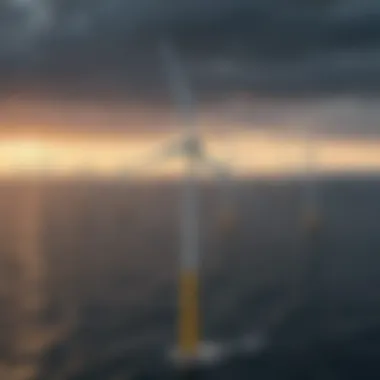
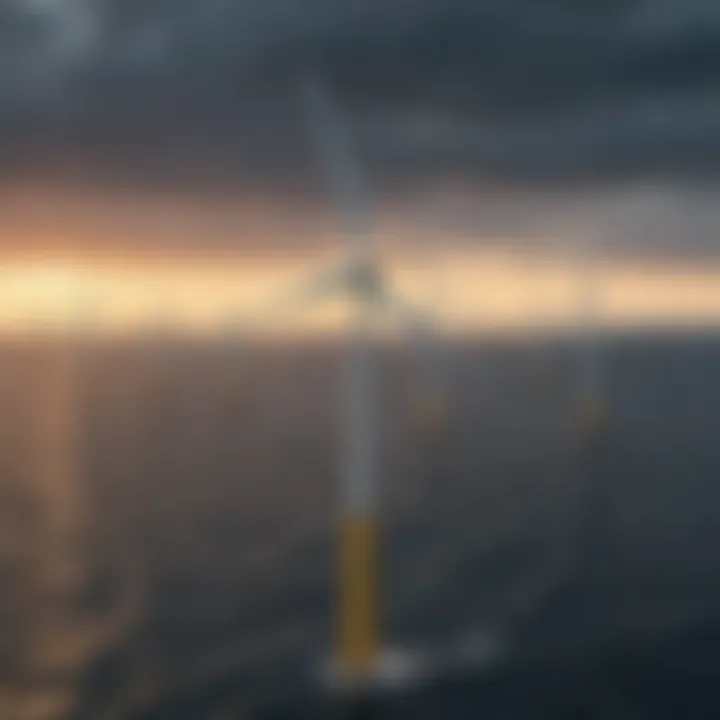
Intro
Wind energy has emerged as a central pillar of the global shift toward sustainable energy solutions. In understanding the unique aspects of both onshore and offshore wind energy, one can appreciate their respective contributions to combating climate change and supporting renewable energy targets. Each has its set of advantages and challenges, shaped by technological innovations and environmental considerations.
By dissecting the intricacies and differences between onshore and offshore wind energy, we can observe how each system operates in distinct contexts. Onshore wind farms are typically more accessible and less expensive to install. However, they may encounter issues such as land use conflicts and local opposition. Offshore wind energy, conversely, harnesses stronger and more consistent winds, though it faces significant challenges related to construction, maintenance, and environmental impacts. Understanding these elements is vital for informed discussions about the future of wind power.
This article aims to deliver a comprehensive analysis of these two forms of wind energy, exploring their respective roles in our sustainable energy future. From examining the economic implications to assessing their environmental footprints, we endeavor to highlight the importance of harnessing wind power as a viable solution to meet growing global energy demands.
Foreword to Wind Energy
Wind energy stands as a potent source of renewable energy, playing a pivotal role in addressing global energy challenges. The reliance on fossil fuels creates significant environmental and economic concerns, highlighting the necessity for sustainable alternatives. Wind energy, with its vast potential to harness natural power, emerges as a promising solution. This section delves into the definition and importance of wind energy, alongside its global adoption trends.
Definition and Importance
Wind energy can be defined as the energy carried by wind, which is transformed into electricity using wind turbines. This conversion process is not merely a technical feat; it symbolizes a shift toward more sustainable energy systems. The importance of wind energy lies in its numerous benefits: it is clean, abundant, and increasingly cost-effective. Unlike fossil fuels, wind energy produces no greenhouse gases during operation, contributing to a more sustainable planet.
Furthermore, wind energy fosters energy independence, reducing reliance on imported fuels. This independence enriches a nation's security and economic resilience. As technology advances, the efficiency of wind turbines continues to improve, thereby enhancing the overall utility of wind energy.
Global Adoption Trends
Over recent decades, there has been a marked increase in the adoption of wind energy worldwide. According to the Global Wind Energy Council, total global wind capacity reached over 743 gigawatts by the end of 2022. This expansion reflects a growing recognition of the need for cleaner energy solutions.
The trends in global wind energy adoption showcase several critical factors:
- Government Policies: Countries are implementing supportive policies and incentives to encourage investment in wind energy.
- Technological Advancement: Innovations in turbine design and efficiency lead to lower costs and higher energy output.
- Public Awareness: Increasing awareness about climate change drives demand for sustainable energy sources.
In regions such as Europe and North America, the installation of onshore and offshore wind farms continues to rise impressively. Nations like Germany and China are leading in this transformation, investing heavily in wind infrastructure. As global energy demands escalate, the shift towards adopting wind energy becomes not just beneficial but imperative.
"The capacity of wind energy to reshape our energy landscape could be as significant as any other renewable technology."
In summary, understanding the definition and global trends surrounding wind energy provides a critical foundation as we explore both onshore and offshore applications in subsequent sections. The commitment to harnessing wind power integrates seamlessly into broader energy strategies and remains central to achieving sustainability goals.
Onshore Wind Energy
Onshore wind energy stands at the forefront of renewable energy solutions. It plays a vital role in the global effort to harness sustainable energy. The increasing demand for clean energy has led to a surge in the development of onshore wind farms. This section aims to dissect the multifaceted aspects of onshore wind energy, specifically focusing on its characteristics, advantages, challenges, and innovative technological solutions that define this sector.
Characteristics of Onshore Wind Farms
Onshore wind farms are typically located on land, utilizing existing terrains to capture wind. These farms can vary significantly in size. Each farm may consist of a few turbines or several hundred. The turbines are designed to convert wind kinetic energy into electricity. In general, onshore wind turbines can range in height from 80 to 120 meters. They are engineered to operate efficiently at various wind speeds. The installation of these farms is often simpler and less costly compared to offshore options. They require access to reliable transportation networks, power lines, and sometimes the presence of federal or state incentives.
Advantages of Onshore Wind Energy
Onshore wind energy presents various compelling benefits. Cost-effectiveness is a prominent advantage. The overall lifecycle cost of onshore wind energy has seen a remarkable decrease over the last decade, making it one of the most affordable sources of energy today. Moreover, onshore wind farms generate clean energy. They produce no greenhouse gas emissions during operation, contributing significantly to the reduction of reliance on fossil fuels.
Another notable benefit is land use. Often, onshore wind farms occupy areas that allow for co-use. Agriculture can continue alongside wind energy production, benefiting farmers economically without impairing the land's original purpose.
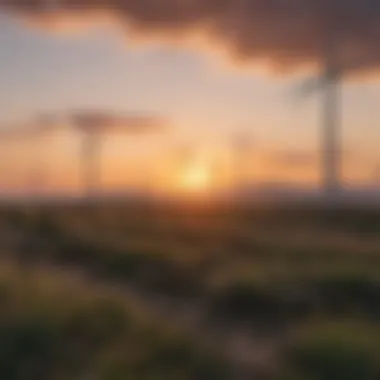
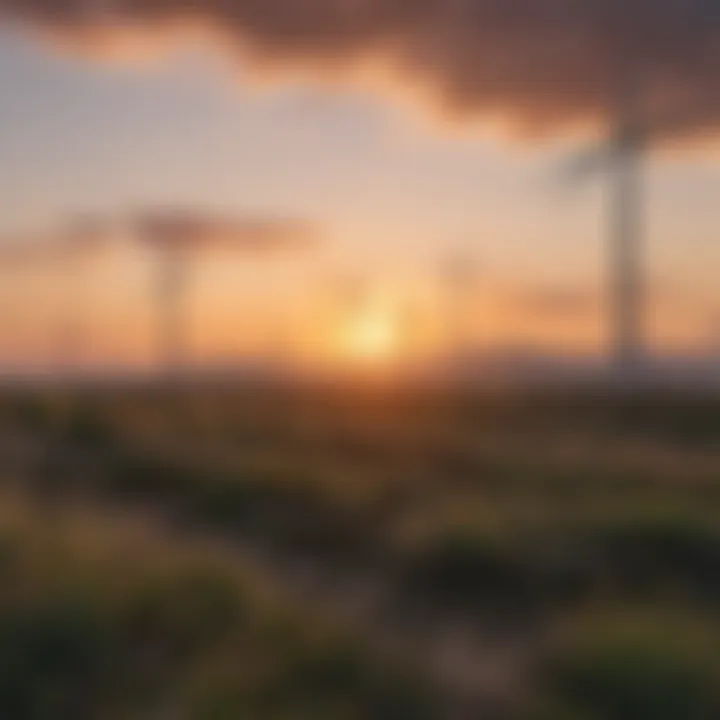
Challenges and Limitations
Despite the advantages, onshore wind energy faces several challenges. The intermittency of wind is a well-known limitation. Wind availability can fluctuate, affecting energy generation consistency. Furthermore, there are concerns related to aesthetic impacts. Some communities may oppose the construction of wind farms due to their visual presence on the landscape. Noise produced by the turbines can also raise objections among nearby residents. Wildlife impact is another area to consider, particularly bird and bat fatalities near turbine blades.
Technological Innovations
The onshore wind industry continually evolves due to technological advancements. Recent innovations focus on turbine efficiency, allowing for larger and more powerful units. Improvements in battery technology also enhance the capability to store energy, mitigating some of the intermittency issues previously mentioned. Furthermore, software advances enable better wind forecasting and energy management, optimizing energy distribution. Intelligent turbine installations equipped with sensors make it possible to monitor performance in real-time, leading to improved maintenance practices.
Case Studies in Onshore Wind Development
Several case studies highlight successful onshore wind projects. The Gansu Wind Farm in China represents one of the largest onshore wind initiatives worldwide. This extensive project significantly contributes to China's renewable energy capacity. In the United States, the Texas Wind Energy sector demonstrates remarkable growth, with the state being a leader in onshore wind power production. Projects like the Ivanpah Solar Electric Generating System show how integration between different energy sources is viable, combining solar and wind capabilities. These examples underscore ongoing shifts in energy paradigms, emphasizing the importance of onshore wind farms in achieving sustainable energy goals.
Offshore Wind Energy
Offshore wind energy plays a significant role in the contemporary energy landscape, providing a sustainable method for electricity generation. With an emphasis on harnessing wind power over marine environments, offshore wind farms are positioned to tap into more robust and consistent wind currents than those found on land. This makes them particularly beneficial for countries looking to increase their renewable energy sources to meet growing demands. The importance of this section lies in the detailed exploration of the characteristics and advantages of offshore wind energy, alongside considerations of challenges, innovations, and real-world examples of successful implementations.
Characteristics of Offshore Wind Farms
Offshore wind farms are fundamentally different from their onshore counterparts in several key aspects. They typically consist of larger turbines, which are capable of generating significantly more power. For instance, many offshore turbines exceed 10 megawatts in capacity. The installation of these turbines often occurs in clusters, forming extensive wind farms that can cover vast areas of the ocean. This assembly allows for more effective maintenance and energy production efficiency.
These farms are designed to withstand marine conditions, including strong winds and saltwater corrosion, which can affect the longevity of wind turbines. Additionally, the location of offshore wind farms usually minimizes conflicts with land use, thereby allowing for unobstructed access to elevated wind speeds.
Advantages of Offshore Wind Energy
The benefits of offshore wind energy are substantial and multi-faceted:
- Higher Energy Generation: As mentioned earlier, the consistency of ocean winds leads to higher capacity factors compared to onshore farms.
- Reduced Visual Impact: Offshore installations are less visible to coastal communities, reducing opposition commonly seen with onshore projects.
- Job Creation: The growth of offshore wind energy contributes to local economies through the creation of jobs in areas such as manufacturing, installation, and maintenance.
- Enhanced Energy Security: Diversifying energy sources through offshore wind can bolster a country's energy independence, reducing reliance on imported fuels.
- Environmental Benefits: Offshore wind energy has a lower overall environmental footprint compared to fossil fuels, aligning with global sustainability goals.
Challenges and Limitations
Despite its advantages, offshore wind energy does face a range of challenges that warrant careful consideration:
- High Initial Costs: The construction of offshore wind farms involves significant investment, from turbine manufacturing to installation and infrastructure development.
- Technological Risks: Offshore environments can be unpredictable; turbines and equipment may face increased wear and tear.
- Regulatory Hurdles: Different countries have varying laws affecting offshore wind developments, which can slow project timelines.
- Impact on Marine Ecosystems: There are ongoing debates about the ecological impact of building structures in marine habitats, which could affect local wildlife.
Technological Innovations in Offshore Wind
Innovation is at the heart of advancing offshore wind energy. Various developments are reshaping the sector, including:
- Floating Wind Turbines: These turbines can be deployed in deeper waters where traditional fixed-bottom turbines cannot operate.
- Enhanced Turbine Designs: Advances in blade technology and materials are allowing for larger and more efficient turbines, which can generate more power from the same wind resources.
- Artificial Intelligence & Big Data: These tools are being used for predictive maintenance, optimizing operational efficiency, and improving turbine designs package.
Case Studies in Offshore Wind Development
Several successful offshore wind projects illustrate the potential of this energy source:
- Hornsea One in the United Kingdom is one of the world's largest offshore wind farms, generating approximately 1.2 gigawatts of power.
- Block Island Wind Farm in the United States demonstrates the first offshore wind farm to operate in the U.S., showcasing the feasibility of offshore projects in North America.
- Gemini Wind Park in the Netherlands employs innovative technology to maximize efficiency and reduce the overall costs of energy production.
In summary, offshore wind energy presents compelling advantages, making it an essential player in the transition to renewable energy. However, it also faces challenges that require innovative solutions and thoughtful policy frameworks to be fully realized.

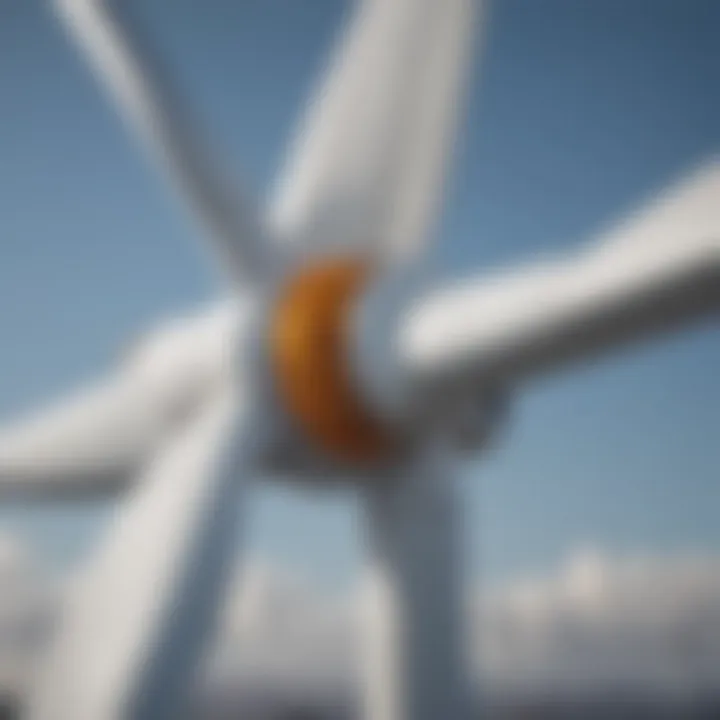
Comparative Analysis of Onshore and Offshore Wind Energy
Understanding the differences between onshore and offshore wind energy is essential for stakeholders in the energy sector. This section provides a comprehensive comparative analysis focusing on cost, energy production efficiency, and environmental impact. By evaluating these elements, one can gain insights into the distinct advantages and disadvantages of each type of wind energy generation, guiding informed decisions on energy investments and policy-making.
Cost Comparison
Cost is a crucial factor in evaluating both onshore and offshore wind energy. Onshore wind farms typically incur lower installation and maintenance costs than their offshore counterparts. The initial capital requirement for onshore facilities generally averages between 1,200 to 1,700 dollars per megawatt (MW). In contrast, offshore wind energy projects tend to exceed 3,000 dollars per MW, largely due to marine logistics, turbine installation, and grid connection complexities.
However, the operational costs of offshore wind farms are decreasing rapidly. Technological advancements have improved the efficiency of offshore turbines and reduced installation times. It is important to consider these decreasing costs when analyzing long-term viability. Furthermore, government incentives play an important role in shaping the financial landscape for both wind types. As markets evolve, the cost dynamics may change significantly, influencing future investments.
Energy Production Efficiency
Energy production efficiency is another critical aspect of comparing wind energy sources. Offshore wind farms often benefit from higher wind speeds and steadier breezes, leading to greater energy output. Studies indicate that offshore installations can achieve capacity factors of 50% or higher. In contrast, onshore projects tend to average between 30% to 40%. This higher capacity translates to more electricity generated per installed MW, which can enhance the overall return on investment.
However, it should be noted that efficiency is influenced by geographic location and regulatory frameworks. Areas with dense wind currents, whether onshore or offshore, will yield the best outcomes. Thus, a thorough analysis must take site-specific variables into account, balancing production aspects with cost considerations.
Environmental Impact Assessment
Environmental impact is a complex issue in wind energy development. Onshore wind farms often affect local ecosystems and wildlife, particularly bird and bat populations. Land use must also be considered, as some regions may face constraints related to agriculture or conservation efforts.
On the other hand, offshore wind energy projects can have less impact on land ecosystems, but they are not without challenges. These projects can affect marine life and are often subject to stricter regulatory scrutiny. Noise during construction and potential changes in water currents are significant concerns that must be evaluated thoroughly.
A critical component of analyzing environmental impact involves conducting comprehensive studies prior to implementation. Stakeholders should prioritize sustainable practices that mitigate any negative effects resulting from wind energy operations. Furthermore, understanding regulatory requirements is key to promoting responsible energy development.
"Evaluating both costs and environmental impacts of wind energy types is essential for a sustainable energy transition."
Assessing onshore and offshore wind energy uses a systematic approach focusing on cost, efficiency, and environmental impact. Each area revealed distinct elements that play a significant role in shaping energy policies and operational strategies.
The findings suggest that future developments in wind energy should balance economic feasibility with environmental considerations to support a sustainable energy framework.
Economic Implications of Wind Energy
The exploration of wind energy's economic implications is vital in understanding its role in the global energy landscape. This section covers the investment trends and the job creation associated with wind energy development, highlighting how this renewable source impacts not only the environment but also economies worldwide. The significance of wind energy extends beyond sustainable practices; it presents opportunities for growth, innovation, and social well-being.
Investment Trends
Investment trends in wind energy show a strong and growing interest. Governments and private sectors are increasingly recognizing the potential returns. Funding often comes from various sources including public incentives, green bonds, and venture capital. The transformative potential of wind projects generates significant interest.
- Public Funding: Many governments provide incentives to attract investment in renewable energy. This includes grants, tax credits, and subsidies that reduce initial project costs. Countries like Germany and China lead in investments, bolstered by governmental support.
- Private Sector Investment: This segment is witnessing substantial growth. Companies see wind energy as not only an eco-friendly choice but also a profitable one. Investments from private equity are becoming common, with firms seeking diversified portfolios.
- Market Growth: The wind energy market is expected to continue expanding, driven by technological innovation and decreased costs. For example, costs related to installing offshore wind farms are decreasing, making it a more appealing investment.
"The global installed capacity of wind power has increased dramatically, reaching over 650 GW as of 2020, which significantly impacts job markets and technology development."
As investment trends evolve, they reflect broader economic shifts toward sustainability. This shift may encourage upcoming economies to adopt similar practices in renewable energy.
Job Creation and Economic Benefits
Wind energy not only contributes to environmental sustainability but also to significant job creation. The sector employs a range of professionals in various capacities, from engineers to project managers. The benefits of job creation in this industry are manifold.
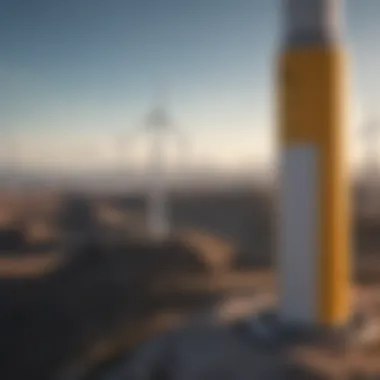
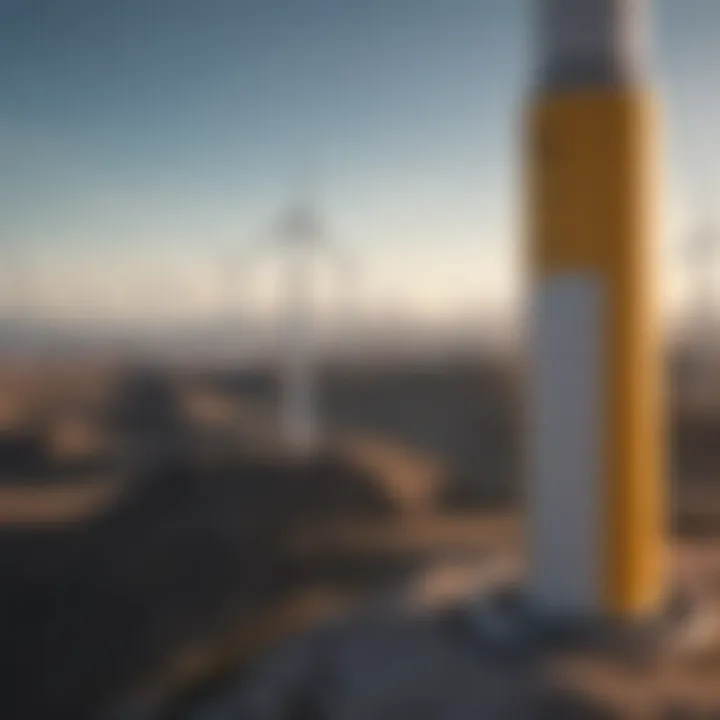
- Direct Employment: The installation of wind turbines and the establishment of wind farms require skilled labor. Jobs in manufacturing and construction flourish as projects take shape. Skilled workers often have stable and well-paying positions that contribute to local economies.
- Indirect Employment: The impact extends beyond direct jobs. Supplying companies that provide materials and services also benefit, creating additional jobs.
- Long-Term Economic Growth: Areas that embrace wind energy projects often experience increased investments. Improved infrastructure, like roads and transmission lines, enhances local economies. This broader economic development encourages further investment into other sectors.
While analyzing economic implications, it becomes evident that wind energy acts as a catalyst. It reinforces economic resilience by promoting job creation and attracting funding, ultimately leading the way for sustainable development.
Future Trends in Wind Energy
The future of wind energy is positioned to play a critical role in the global energy landscape. With the rise of climate consciousness and the urgent need for sustainable energy solutions, wind energy emerges as a pivotal source. This section delves into several key elements shaping the future of wind energy, focusing on innovations, policy developments, and the integration with other renewable sources.
Innovations on the Horizon
The wind energy sector continues to witness rapid advancements in technology. Innovations are not just incremental; some are transformative. Emerging technologies include larger and more efficient turbine designs, which can capture more wind energy in diverse conditions.
- Floating Wind Turbines: These structures allow for deeper ocean installation. Floating platforms can harness powerful winds that are less turbulent and more consistent than onshore locations.
- Vertical Axis Wind Turbines (VAWT): Unlike conventional turbines, VAWTs can operate efficiently regardless of wind direction. This flexibility can enhance energy capture in varied environments.
- Smart Grids Integration: Advanced grid systems are being developed to optimize energy distribution from wind farms, ensuring efficiency and reliability.
"Technological advancements in wind energy can lead to a significant reduction in costs and an increase in energy production efficiency, making this renewable source increasingly viable."
Policy and Regulation Developments
Policy frameworks play a crucial role in the development of wind energy. Governments worldwide are beginning to recognize the importance of wind energy within their energy strategies. Recent trends include:
- Incentives and Subsidies: Many regions are offering financial support for wind energy projects. This encourages investment and facilitates market entry for new technologies.
- Global Agreements: International pacts aimed at reducing carbon emissions are pushing wind energy to the forefront. These agreements often include ambitious targets that increase the demand for renewable energy systems.
- Local Regulations: Cities and states are defining specific regulations to streamline the permitting process for wind farms. This helps expedite project timelines and attracts more investors.
Integration with Other Renewable Energy Sources
Finally, integration with other renewable energy sources is pivotal for creating a resilient and sustainable energy grid. Wind energy complements other systems effectively, enabling a more stable supply of electricity.
- Solar-Wind Hybrid Systems: Combining solar panels with wind turbines optimizes resource use, especially in regions with variable weather patterns. This ensures steady energy production throughout the day and night.
- Energy Storage Solutions: Enhancements in battery technology allow for the storage of excess energy produced during high-wind periods, making it available during low-wind times.
- Microgrid Systems: Localized grids can manage energy from multiple sources, including wind, solar, and even traditional forms of energy. This minimizes waste and maximizes resource utilization.
The strategies outlined demonstrate a commitment to harnessing wind energy as part of a wider global approach to sustainability. The next few years will likely be filled with pivotal changes and expansive opportunities within this domain.
Epilogue
The conclusion of this article encapsulates the significant points discussed about onshore and offshore wind energy. Wind energy plays a crucial role in the global shift towards sustainable resources. Both types of wind energy possess unique attributes that contribute to their value. The advances in technology are paving the way for more efficient energy production, thus making wind a core component of renewable energy strategy.
Summarizing Key Points
Throughout the article, we examined various facets of wind energy:
- Definition and importance: Wind energy is defined as the power generated from wind currents. Its significance lies in reducing dependence on fossil fuels and mitigating climate change.
- Global trends: The adoption of wind energy is expanding globally, brushing aside previous skepticism towards its viability.
- Onshore vs Offshore: Onshore wind farms are easier and cheaper to install. In contrast, offshore installations generally produce higher electricity output but come with higher costs and complexities.
- Economic implications: Financial investments in wind energy are rising, and such investments result in job creation and economic benefits for rural areas.
- Future prospects: The continual development of wind energy technologies and supportive policies are vital to enhance energy integration into existing power grids.
- Environmental impact: Although both types of energy have some ecological footprint, the overall benefits to the environment far outweigh these drawbacks.
The Future of Wind Energy in a Sustainable World
Considering the future of wind energy, several factors are imperative to discuss. First, innovation is key to further maximizing output and minimizing costs. For instance, companies are developing more effective turbine designs to capture wind energy efficiently even at lower speeds.
Moreover, policies will greatly influence the future of wind energy. Governments need to formulate supportive agendas that encourage growth and investment in wind energy sectors. These policies should benefit both onshore and offshore developments to ensure a balanced approach.
Integration with other renewable energy sources will also prove essential. The synergy created by combining wind energy with solar or hydroelectric power can lead to a more stable energy supply and further diminish reliance on nonrenewable sources. This intersection of different energy solutions will enhance the overall effectiveness of the transition to a sustainable energy future.
"The future of wind energy rests on our ability to adapt and innovate in the face of changing global realities."
For more information, you might explore additional resources on Wikipedia or Britannica.
This overview encapsulates the urgency and importance of harnessing wind energy as part of the broader effort to address global energy needs and environmental concerns.







